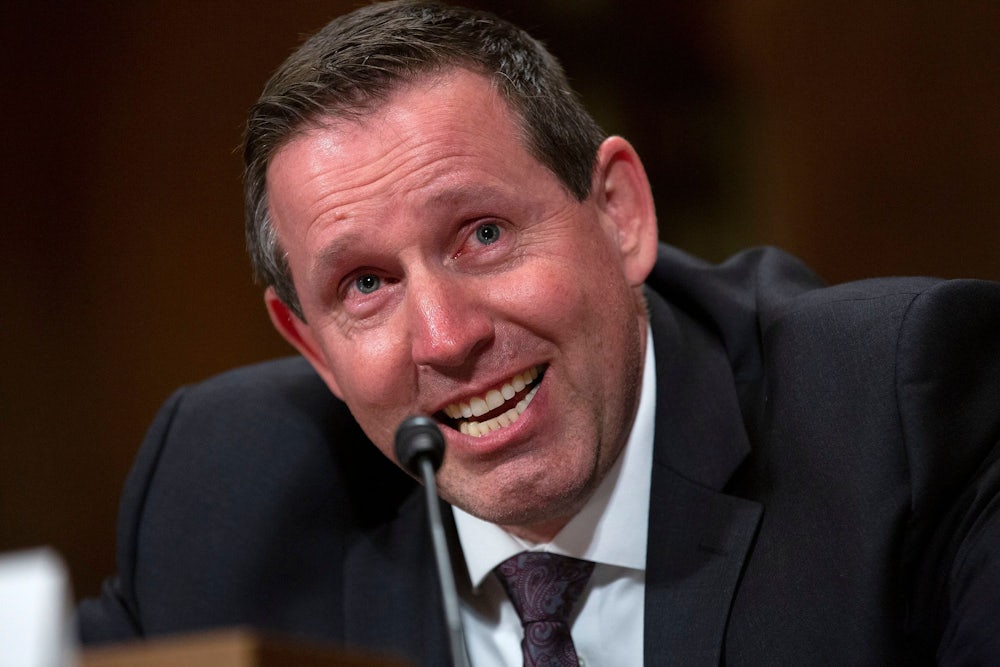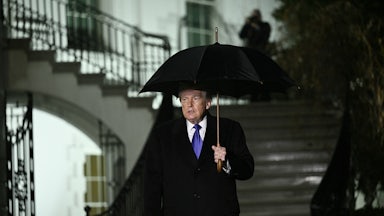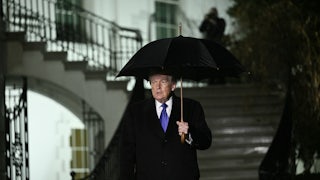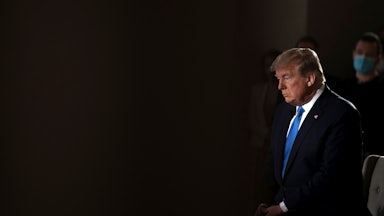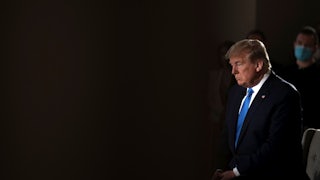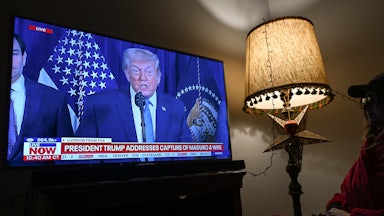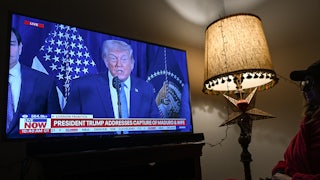The federal judiciary is pretty big. There are between 800 and 900 federal judges working across the United States on any given day. Federal district courts hear more than a quarter-million new cases each year. Tens of thousands of decisions are reviewed by the federal appellate courts every year, and the Supreme Court itself reviews fewer than 100 of those courts’ decisions in full.
I have not read all of those decisions and opinions—no human being can. But I am fairly sure that nobody is writing them quite like Judge Lawrence VanDyke, a Trump appointee on the Ninth Circuit Court of Appeals. His caustic writings, particularly in hot-button cases, have veered into broad personal attacks on his fellow judges out of frustration with rulings with which he disagrees. At times, they read more like partisan op-ed columns than judicial opinions. They are a disservice to the federal courts on which he serves—and nothing can be done about it.
Consider his writings in McDougall v. County of Ventura earlier this month. VanDyke served on a three-judge panel that reviewed a lower court’s decision on Covid-19 orders issued in Ventura County, California. When the pandemic began in March 2020, Ventura County issued a series of stay-at-home orders that instructed residents not to leave their homes except to work in an essential service or shop at an essential business. The public health orders, like many similar ones across the country, ended in early May 2020.
One week after they had been issued, however, two residents and a coalition of gun-rights groups sued the county. They argued that the order had violated their Second Amendment rights by denying them the opportunity to buy guns and ammunition. (Guns can’t be lawfully purchased online.) A federal district court dismissed their lawsuit soon thereafter. The court cited both the Supreme Court’s 1905 decision in Jacobson v. Massachusetts, which recognized broad state and local powers to curb epidemics, as well as the Ninth Circuit’s own Second Amendment jurisprudence.
VanDyke and his colleagues on the three-judge panel read things differently. They reversed the district court and held that the county had, in fact, violated the Second Amendment two years ago. “The acute need for Second Amendment rights during temporary crises was well-understood by our Founders,” he wrote, citing precedents that described the Second Amendment as a “strong moral check against the usurpation and arbitrary power of rulers, and as a necessary and efficient means of regaining rights when temporarily overturned by usurpation.”
In addition to providing a “strong moral check” against public health officials during a pandemic, VanDyke explained, ready access to guns is also necessary to protect against more pedestrian threats. “This is particularly true in these turbulent times of rising crime rates and mass police resignations due to low morale and the onslaught of legislative reform,” he explained in a footnote. “Modern society agrees, as firearm and ammunition sales have soared during the recent pandemic,” he later observed. Most of the rest of the opinion revolved around what level of judicial scrutiny should apply in this case. VanDyke and his colleagues opted for strict scrutiny, which is perhaps the most formidable tier for the government to overcome, instead of intermediate scrutiny, which is the standard in the Ninth Circuit.
If VanDyke had stopped there, his opinion would not stand out from the countless other judicial opinions on Covid-19 measures over the last two years. But VanDyke wrote a concurring opinion to his own majority opinion—an unusual move in and of itself—to lash out at his Ninth Circuit colleagues for how they decide Second Amendment cases. “I’m not a prophet, but since this panel just enforced the Second Amendment, and this is the Ninth Circuit, this ruling will almost certainly face an en banc challenge,” he wrote. (“En banc” means that a larger panel of Ninth Circuit judges will review a three-judge panel’s decision.) “This prediction follows from the fact that this is always what happens when a three-judge panel upholds the Second Amendment in this circuit.”
He then explained, mockingly, that he would write a draft version of the opinion that he thought the en banc Ninth Circuit would issue to overturn his ruling. “To better explain the reasoning and assumptions behind this type of analysis, my ‘alternative’ draft below will contain footnotes that offer further elaboration (think of them as ‘thought-bubbles’),” he wrote. “The path is well-worn, and in a few easy steps any firearms regulation, no matter how draconic, can earn this circuit’s stamp of approval.” I believe the judge meant “draconian” instead of “draconic,” unless he was referring to gun restrictions in a Dungeons & Dragons campaign.
I won’t bother recapping his entire mock-opinion, which can be found here. Suffice it to say that he prefers bright-line tests for gun regulations instead of ones that ask judges to balance interests and burdens along the way. What’s striking is the sheer contempt he has for his colleagues: He refers to their reasoning in past cases as “tricks,” suggests at one point that they “could easily just delegate this part of the [mock] opinion to our interns” when they write it, and derisively (and preemptively) criticizes those colleagues for overturning his ruling, which may not even happen. Again, I have not read every judicial opinion in the republic, but I can’t remember ever reading one as uncollegial by a sitting federal judge. Most of the other opinions that come close, though, were also written by VanDyke.
VanDyke’s road to the federal judiciary was rocky, to say the least. After former President Trump nominated him to the Ninth Circuit in September 2019, the American Bar Association rated him as “not qualified” and, in an unusually blunt letter to the Senate Judiciary Committee, described him as “arrogant, lazy, an ideologue, and lacking in knowledge of the day-to-day practice including procedural rules,” based on interviews with roughly 60 lawyers and judges who worked with him. It went on to say that he “lacks humility, has an ‘entitlement’ temperament, does not have an open mind, and does not always have a commitment to being candid and truthful.”
That led to an extraordinary confirmation hearing before the Senate Judiciary Committee in 2019, where VanDyke tearfully defended himself, including on the reviewer’s claim that he “would not say affirmatively that he would be fair to any litigant before him, notably members of the LGBTQ community.” (VanDyke denied that allegation while testifying before the committee.)
Senate Republicans came to his defense by arguing that the ABA has a bad track record when it comes to rating Republican presidents’ nominees and by questioning the integrity of the reviewer. Six retired Montana Supreme Court justices also urged the court not to confirm VanDyke, who unsuccessfully ran for a seat on the Montana court in 2014. But the controversy ultimately did not prevent the Republican-led Senate from confirming him to the Ninth Circuit.
VanDyke’s behavior on the Ninth Circuit may have been predictable, then, but that doesn’t make it any less troubling. In one immigration case, VanDyke accused other Ninth Circuit judges of “barely disguised shenanigans” and “mischief,” while in another he called circuit precedent “silly” and said the court had a “nasty habit of muddling immigration law.” Last August, when the Ninth Circuit refused to review a three-judge panel decision in a habeas corpus case, he strenuously criticized his colleagues for not reversing the panel’s ruling. He compared the other judges to “a sullen kid who spits in the cookie jar after being caught red-handed,” referring to the Supreme Court’s record of overturning Ninth Circuit habeas rulings. “To give credit where credit is due: my diligent clerk did prepare a very nice string-cite spanning multiple pages,” he said of the list of reversals. “But including it felt awkward—like trying to shame a career offender with his rap sheet.” What a way to describe your co-workers.
Perhaps the best example came in Duncan v. Bonta, a Second Amendment case decided last November by the en banc Ninth Circuit. VanDyke again found himself at odds with his colleagues, this time over California’s virtual ban on large-capacity magazines. Like other federal circuit courts that have considered similar laws, the majority applied intermediate scrutiny and upheld the restrictions. Judge Patrick Bumatay, one of the court’s other conservative members, wrote a lengthy dissent explaining why he thought the Ninth Circuit should abandon the balance-of-interests approach. Instead, he argued, judges should evaluate whether restrictions are rooted in the “text, tradition, and history” of the Second Amendment.
VanDyke, writing separately, said he “largely agreed” with Bumatay’s dissent. So why write his own? He wanted to complain that he thought his colleagues were “possessed maybe—by a single-minded focus on ensuring that any panel opinions actually enforcing the Second Amendment are quickly reversed.” In VanDyke’s eyes, “the majority of our court distrusts gun owners and thinks the Second Amendment is a vestigial organ of their living constitution.” He described mass shootings as “a statistically very rare harm,” akin to airplane crashes, and less lethal overall than car crashes, which kill far more people each year.
Though he engaged with the majority’s legal arguments, he also accused them of operating under their personal biases against guns, and urged the Supreme Court to tighten its Second Amendment rulings to deprive them of any discretion. “Ultimately, it is not altogether surprising that federal judges, who have armed security protecting their workplace, home security systems supplied at taxpayer expense, and the ability to call an armed marshal to their upper-middle class home whenever they feel the whiff of a threat, would have trouble relating to why the average person might want a magazine with over ten rounds to defend herself,” he opined.
This time, his attacks on his colleagues drew a response. In footnotes in her opinion for the court, Judge Susan Graber turned his comparisons to car crashes and plane crashes against him. “A ban on large-capacity magazines cannot reasonably be considered a ban on firearms,” she explained, “any more than a ban on leaded gasoline, a ban on dangerously designed gas tanks, or speed limits could be considered a ban on cars.” And while she agreed on the rarity of airplane crashes, she noted that “legislatures recognize that the serious harm caused by even a single crash justifies extensive regulation of the industry,” similar to the social and personal impact of mass shootings.
Judge Andrew Hurwitz took aim at VanDyke’s claims of personal bias in a concurring opinion. “That language is no more appropriate (and no more founded in fact) than would be a statement by the majority that today’s dissenters are willing to rewrite the Constitution because of their personal infatuation with firearms,” he wrote. Hurwitz noted that some of the judges in the majority own guns themselves and that some also bore them during military service.
Hurwitz also pointedly pushed back against VanDyke’s insinuation that judges were relying on the protection of guns while denying it to others. “However infrequent mass shootings may be, hardly anyone is untouched by their devastation,” Hurwitz noted. “The Ninth Circuit lost one of its own, Chief Judge Roll of the District of Arizona, to precisely such a shooting, notwithstanding Judge VanDyke’s assumption that federal judges are somehow immune from such dangers. Other members of the Court have lost family and friends to gun violence.” VanDyke’s personal attack, he concluded, “neither advances our discourse nor gives intellectual support to the legal positions argued by my respected dissenting colleagues.”
That reference to the other dissenters stands out because, in each of the instances I’ve cited, no other member of the Ninth Circuit joined VanDyke’s dissent in question—even though, in most of them, VanDyke wasn’t the only dissenting judge in the case. The other dissenters simply chose to not join him. The two Second Amendment cases I describe in this piece both feature lengthy dissents by Judge Patrick Bumatay, which manage to lay out his differences with the majority on the Second Amendment without veering into personal attacks. It’s possible that other conservative judges on the Ninth Circuit share VanDyke’s deeper dismay over their court’s decisions. But if they do, they frame it in legal reasoning instead of ad hominem attacks.
VanDyke’s venomous style comes as the federal appellate courts are increasingly split along partisan lines, with en banc cases like the ones where he expresses the most frustration falling more often between Republican and Democratic appointees. But ascribing his behavior to a broader trend among federal judges may let him off the hook too easily. He is still, in this polarized age, a truly exceptional case. So what can be done about him?
The few remedial powers that the federal courts possess over their own judges are not designed to address rudeness or incivility. It’s supposed to be the job of the president and the Senate to ensure that nominees with the appropriate temperament reach the federal bench—a duty that Republicans appear to have failed. And public chastisement by his colleagues doesn’t appear to have had any effect on his open disdain toward them. As a result, VanDyke will almost certainly continue to exercise judicial power for the rest of his life, no matter how much he demeans American jurisprudence along the way.
